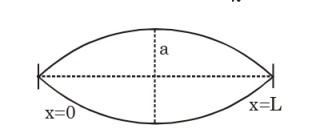A string of mass m is fixed at both ends. The fundamental tone oscillations are excited with circular frequency ω and maximum displacement amplitude amax . Find :
(a) the maximum kinetic energy of the string,
(b) the mean kinetic energy of the string averaged over one oscillation period.
To solve the problem, we need to find the maximum kinetic energy and the mean kinetic energy of a string fixed at both ends, vibrating in its fundamental mode. Let's break this down step by step.
Step 1: Understand the system
We have a string of mass m fixed at both ends, oscillating in its fundamental mode with circular frequency ω and maximum displacement amplitude amax.
Step 2: Determine the mass per unit length
The mass per unit length μ of the string is given by:
μ=mL
where L is the length of the string.
Step 3: Write the wave equation
The displacement of a particle in the string can be described by the wave equation for a standing wave:
y(x,t)=Acos(kx)cos(ωt)
where A=amax is the maximum amplitude, and k is the wave number given by k=2πλ.
Step 4: Find the particle velocity
The particle velocity v is the time derivative of the displacement:
v(x,t)=∂y∂t=−Aωcos(kx)sin(ωt)
Step 5: Calculate the kinetic energy of an element of the string
Consider an infinitesimal element of the string of length dx. The mass of this element is:
dm=μdx=mLdx
The kinetic energy dT of this element is given by:
dT=12dmv2=12(mLdx)(−Aωcos(kx)sin(ωt))2
dT=12mLdxA2ω2cos2(kx)sin2(ωt)
Step 6: Total kinetic energy
To find the total kinetic energy T of the string, integrate dT over the length of the string:
T=∫L0dT=∫L012mLA2ω2cos2(kx)sin2(ωt)dx
Step 7: Evaluate the integral
Using the identity cos2(kx) and integrating:
∫L0cos2(kx)dx=L2
Thus, the total kinetic energy becomes:
T=12mLA2ω2⋅L2sin2(ωt)=mA2ω24sin2(ωt)
Step 8: Maximum kinetic energy
The maximum kinetic energy occurs when sin2(ωt)=1:
Tmax=mA2ω24
Step 9: Mean kinetic energy
To find the mean kinetic energy over one oscillation period T=2πω:
⟨T⟩=1T∫T0Tdt=1T∫T0mA2ω24sin2(ωt)dt
Using the integral ∫T0sin2(ωt)dt=T2:
⟨T⟩=1T⋅mA2ω24⋅T2=mA2ω28
Final Answers:
(a) The maximum kinetic energy of the string is:
Tmax=mA2ω24
(b) The mean kinetic energy of the string averaged over one oscillation period is:
⟨T⟩=mA2ω28
We have a string of mass m fixed at both ends, oscillating in its fundamental mode with circular frequency ω and maximum displacement amplitude amax.
The mass per unit length μ of the string is given by:
μ=mL
where L is the length of the string.
The displacement of a particle in the string can be described by the wave equation for a standing wave:
y(x,t)=Acos(kx)cos(ωt)
where A=amax is the maximum amplitude, and k is the wave number given by k=2πλ.
The particle velocity v is the time derivative of the displacement:
v(x,t)=∂y∂t=−Aωcos(kx)sin(ωt)
Consider an infinitesimal element of the string of length dx. The mass of this element is:
dm=μdx=mLdx
The kinetic energy dT of this element is given by:
dT=12dmv2=12(mLdx)(−Aωcos(kx)sin(ωt))2
dT=12mLdxA2ω2cos2(kx)sin2(ωt)
To find the total kinetic energy T of the string, integrate dT over the length of the string:
T=∫L0dT=∫L012mLA2ω2cos2(kx)sin2(ωt)dx
Using the identity cos2(kx) and integrating:
∫L0cos2(kx)dx=L2
Thus, the total kinetic energy becomes:
T=12mLA2ω2⋅L2sin2(ωt)=mA2ω24sin2(ωt)
The maximum kinetic energy occurs when sin2(ωt)=1:
Tmax=mA2ω24
To find the mean kinetic energy over one oscillation period T=2πω:
⟨T⟩=1T∫T0Tdt=1T∫T0mA2ω24sin2(ωt)dt
Using the integral ∫T0sin2(ωt)dt=T2:
⟨T⟩=1T⋅mA2ω24⋅T2=mA2ω28
(a) The maximum kinetic energy of the string is:
Tmax=mA2ω24
⟨T⟩=mA2ω28
Topper's Solved these Questions
- WAVESBOOK - AAKASH INSTITUTE ENGLISHCHAPTER - WAVESEXERCISE - Assignment (Section-J) (Paragraph Type Questions)
4 Videos
- WAVESBOOK - AAKASH INSTITUTE ENGLISHCHAPTER - WAVESEXERCISE - EXERCISE
20 Videos
- WAVESBOOK - AAKASH INSTITUTE ENGLISHCHAPTER - WAVESEXERCISE - Assignment (Section-I) (Subjective Type Questions)
8 Videos
- WAVE OPTICSBOOK - AAKASH INSTITUTE ENGLISHCHAPTER - WAVE OPTICSEXERCISE - Assignment (Section-J (Aakash Challengers question))
1 Video
- WORK, ENERGY AND POWERBOOK - AAKASH INSTITUTE ENGLISHCHAPTER - WORK, ENERGY AND POWEREXERCISE - Assignment (SECTION - D)
13 Videos
Similar Questions
A simple pendulum of length l has a maximum angular displacement θ. The maximum kinetic energy of the bob of mass m will be
View SolutionA string is fixed at both end transverse oscillations with amplitude a0 are excited. Which of the following statements are correct ?
View SolutionA simple pendulum of length l has maximum angular displacement θ . Then maximum kinetic energy of a bob of mass m is
View SolutionA particle performing SHM with angular frequency ω=5000 radian/second and amplitude A=2 cm and mass of 1 kg. Find the total energy of oscillation.
View SolutionA string fixed at both ends first oscillates in its fundamental mode then in second harmonic mode.Then match the following.

View SolutionA string of length 'L' is fixed at both ends . It is vibrating in its 3rd overtone with maximum amplitude 'a'. The amplitude at a distance L/3 from one end is
View SolutionA rod of mass m spins with an angular speed ω=√gl, Find its a. kinetic energy of rotation. b. kinetic energy of translation c. total kinetic energy.

View SolutionA string of mass 'm' and length l, fixed at both ends is vibrating in its fundamental mode. The maximum amplitude is 'a' and the tension in the string is 'T'. If the energy of vibrations of the string is π2a2TηL. Find η
View SolutionA string of mass per unit length μ is clamped at both ends such that one end of the string is at x=0 and the other is at x=L. When string vibrates in fundamental mode, amplitude of the midpoint of string is a and tension in the string is F. Find the total oscillation energy (in J) stored in the string. (Use L=1 m, F = 10N, a = 1/pi m).

View SolutionA uniform string is clamped at x=0 and x = L and is vibrating in its fundamental mode. Mass per unit length of the string is μ, tension in it is T and the maximum displacement of its midpoint is A. Find the total energy stored in the string. Assume to be small so that changes in tension and length of the string can be ignored
View Solution
